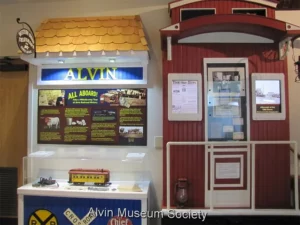
Gulf, Colorado & Santa Fe Railroad (2:41)
Caboose display: The left side video shows old railroad advertisements from the Alvin Sun Newspapers. Please note how the newspaper banner changed over the years. The right side video shows photographs of railroad centered activities. Please note the long lines waiting to unload produce for loading onto the trains. Also note the pictures of snow from 1895 when 2 feet of snow fell and Galveston Bay froze over. The center picture was taken in 1940 of E. J. Berry who was a telegraph operator in the Alvin Depot. The Certificate for $100,000 of Gulf, Colorado, and Santa Fe stock (over a third of the value of the railroad at that time) was issued to George Sealy, one of the 1st people to invest in the railroad. He was later the total owner. Note the railway passes from 1928 and 1887. One of the passes is for Webster Snyder, for whom the town of Webster is named. This pass allowed him free passage on the railroad.
Train Depot display: The Gulf, Colorado, and Santa Fe railroad, was named for locations it ultimately was intended to reach. Galveston (the major cotton shipping point in Texas) already had a rail service through Houston. Houston wanted to develop their ship channel in competition with Galveston. The state legislature had a law that if an outbreak of serious disease took place, a community could stop all traffic flowing from the location with the outbreak. Houston would periodically (during cotton shipping season) decided that Galveston had a Yellow Fever outbreak and would stop all commerce flowing through Houston. They could then pick up a major portion of the trade. Galveston grew tired of it and decided to build a railroad to bypass Houston (the Gulf, Colorado & Santa Fe).
The original depot (pictured in the graphic) was called the Little Red Depot and was built in 1889. It was built after George Sealy sold the railroad to the Atchison, Topeka and Santa Fe railroad in 1885. The depot wasn’t well liked since it was cold and drafty. The second one (recently renovated by the city) was built in 1910.
The artifacts in the case include a telegraph key used at our depot and a Wells Fargo envelope used to send money. Note the wax seals imbedded with “WELLS, FARGO & CO’S ALVIN, TEX”. Western Union telegrams, and various badges and name plates are also displayed.
